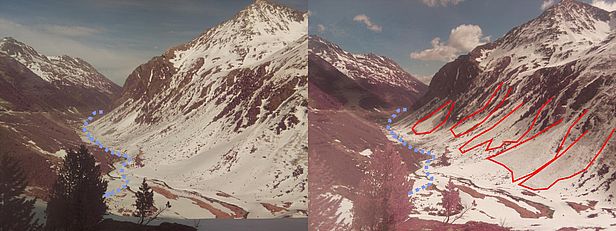29.11.2022 | Lisa Bose, Sara Niedermann | News SLF
Most avalanches that occur in the mountains go undetected. However, for road safety in particular, knowing exactly where and when such an event has occurred is important so that the authorities can clear and re-open the affected road as quickly and easily as possible. The data could also be used by the avalanche warning system to refine its forecasts. In addition, avalanche researchers would like to establish exactly when events happened with a view to enhancing their forecasting models.
Existing fibre optic telecoms cables could now be used to monitor avalanches in the field. These respond to vibrations in the ground involving minimal deformation. A device transmitting laser pulses into the cables measures these vibrations, meaning that the cables can be used as seismic sensors. "This technology is nothing new, but this is the first time it's been used to detect avalanches," says Alec van Herwijnen, an avalanche researcher at the WSL Institute for Snow and Avalanche Research (SLF).
In the winter of 2021/2022, the researchers used an existing fibre optic cable network in Switzerland between Susch and the Flüela Pass to conduct tests. Pascal Edme from the Seismology and Wave Physics group at ETH Zurich is responsible for analysing the data. His team identified a number of avalanches that crossed or occurred next to a cable running along the pass.
Cameras installed to check signals ¶
The researchers rigged up three cameras along the 9-kilometre route to check whether the vibration signals really came from avalanches. Two periods were recorded: one with relatively big dry avalanches and the other with a lot of wet snow avalanches. "What we saw in the images matched the signals we received from the cable," says Alec. However, it is almost impossible to detect avalanches that start several kilometres away. "They would have to be very big avalanches," explains Alec. "However, our data did clearly show the eruption of the Hunga Tonga-Hunga Ha'apai volcano in the Pacific in mid-January 2022."
Large range, large data volumes ¶
However, deploying this system in the field is far from straightforward. The problem is that, while it has a large range and could in theory monitor entire mountain passes, every vibration in the ground generates a signal that is reflected in the data. "To monitor an entire area, we will need new methods, such as machine learning, to analyse the enormous amounts of data produced," says Alec. All the same, he firmly believes that monitoring using fibre optic cables has potential and that research into applying this technology will come on leaps and bounds in the years ahead.
This article appeared in German in Davoser Zeitung on 29 November 2022, and in slightly abridged form in the WSL magazine DIAGONAL 22/2. DIAGONAL is available free of charge and can be subscribed to or downloaded in PDF format at slf.ch.
Contact ¶
Copyright ¶
WSL and SLF provide the artwork for imaging of press articles relating to this media release for free. Transferring and saving the images in image databases and saving of images by third parties is not allowed.

